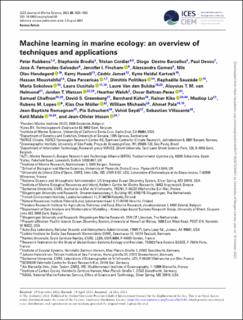| dc.contributor.author | Rubbens, Peter | |
| dc.contributor.author | Brodie, Stephanie | |
| dc.contributor.author | Cordier, Tristan | |
| dc.contributor.author | Desto Barcellos, Diogo | |
| dc.contributor.author | DeVos, Paul | |
| dc.contributor.author | Fernandes-Salvador, Jose A | |
| dc.contributor.author | Fincham, Jennifer | |
| dc.contributor.author | Gomes, Alessandra | |
| dc.contributor.author | Handegard, Nils Olav | |
| dc.contributor.author | Howell, Kerry L. | |
| dc.contributor.author | Jamet, Cédric | |
| dc.contributor.author | Kartveit, Kyrre Heldal | |
| dc.contributor.author | Moustahfid, Hassan | |
| dc.contributor.author | Parcerisas, Clea | |
| dc.contributor.author | Politikos, Dimitris V. | |
| dc.contributor.author | Sauzède, Raphaëlle | |
| dc.contributor.author | Sokolova, Maria | |
| dc.contributor.author | Uusitalo, Laura | |
| dc.contributor.author | Van den Bulcke, Laure | |
| dc.contributor.author | van Helmond, Aloysius | |
| dc.contributor.author | Watson, Jordan T. | |
| dc.contributor.author | Welch, Heather | |
| dc.contributor.author | Beltran-Perez, Oscar | |
| dc.contributor.author | Chaffron, Samuel | |
| dc.contributor.author | Greenberg, David S. | |
| dc.contributor.author | Kühn, Bernhard | |
| dc.contributor.author | Kiko, Rainer | |
| dc.contributor.author | Lo, Madiop | |
| dc.contributor.author | Lopes, Rubens M. | |
| dc.contributor.author | Möller, Klas Ove | |
| dc.contributor.author | Michaels, William | |
| dc.contributor.author | Pala, Ahmet | |
| dc.contributor.author | Romagnan, Jean-Baptiste | |
| dc.contributor.author | Schuchert, Pia | |
| dc.contributor.author | Seydi, Vahid | |
| dc.contributor.author | Villasante, Sebastian | |
| dc.contributor.author | Malde, Ketil | |
| dc.contributor.author | Irisson, Jean-Olivier | |
| dc.date.accessioned | 2023-10-26T06:34:41Z | |
| dc.date.available | 2023-10-26T06:34:41Z | |
| dc.date.created | 2023-10-13T10:27:59Z | |
| dc.date.issued | 2023 | |
| dc.identifier.issn | 1054-3139 | |
| dc.identifier.uri | https://hdl.handle.net/11250/3098824 | |
| dc.description.abstract | Machine learning covers a large set of algorithms that can be trained to identify patterns in data. Thanks to the increase in the amount of data and computing power available, it has become pervasive across scientific disciplines. We first highlight why machine learning is needed in marine ecology. Then we provide a quick primer on machine learning techniques and vocabulary. We built a database of ∼1000 publications that implement such techniques to analyse marine ecology data. For various data types (images, optical spectra, acoustics, omics, geolocations, biogeochemical profiles, and satellite imagery), we present a historical perspective on applications that proved influential, can serve as templates for new work, or represent the diversity of approaches. Then, we illustrate how machine learning can be used to better understand ecological systems, by combining various sources of marine data. Through this coverage of the literature, we demonstrate an increase in the proportion of marine ecology studies that use machine learning, the pervasiveness of images as a data source, the dominance of machine learning for classification-type problems, and a shift towards deep learning for all data types. This overview is meant to guide researchers who wish to apply machine learning methods to their marine datasets. | en_US |
| dc.language.iso | eng | en_US |
| dc.publisher | Oxford University Press | en_US |
| dc.relation.uri | Crimac.no | |
| dc.rights | Navngivelse 4.0 Internasjonal | * |
| dc.rights.uri | http://creativecommons.org/licenses/by/4.0/deed.no | * |
| dc.title | Machine learning in marine ecology: an overview of techniques and applications | en_US |
| dc.type | Journal article | en_US |
| dc.type | Peer reviewed | en_US |
| dc.description.version | publishedVersion | en_US |
| dc.rights.holder | Copyright The Author(s) 2023 | en_US |
| cristin.ispublished | true | |
| cristin.fulltext | original | |
| cristin.qualitycode | 2 | |
| dc.identifier.doi | https://doi.org/10.1093/icesjms/fsad100 | |
| dc.identifier.cristin | 2184364 | |
| dc.source.journal | ICES Journal of Marine Science | en_US |
| dc.source.pagenumber | 1829-1853 | en_US |
| dc.relation.project | Norges forskningsråd: 309512 | en_US |
| dc.identifier.citation | ICES Journal of Marine Science. 2023, 80 (7), 1829-1853. | en_US |
| dc.source.volume | 80 | en_US |
| dc.source.issue | 7 | en_US |

